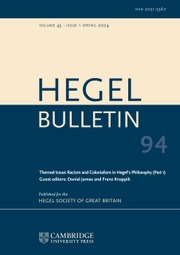Article contents
Ibsen and Hegel on Egypt and the Beginning of Great Art1
Published online by Cambridge University Press: 23 June 2015
Abstract
In the young Henrik Ibsen's intellectual quarters, abroad as well as in his native Norway, Hegelianism was very much the philosophical system de rigueur. Hegel's student Marcus Jacob Monrad taught phenomenology and aesthetics at the University of Christiania (now Oslo) throughout the 1850s, and promoted a wider Hegelian way of thinking through frequent book reviews and newspaper articles. In Italy, soon to be his home away from home, Ibsen socialised with the art-historian Lorentz Dietrichson, whose views on the history of art were outspokenly Hegelian. Ibsen was also in touch with the Hegelian circle gathering around the painter I. C. Dahl at the Academy of Art in Dresden. While Ibsen rarely engages in explicit philosophical discussion, he makes a significant exception when responding to the Danish translation of John Stuart Mill's Utilitarianism. He admits that he has no professional expertise in this area but continues to observe that, insofar as ‘there are writers [like Mill] who lay down the law about philosophy without any knowledge of Hegel or German thought in general,’ it seems to him that ‘anything is allowed.’ To think philosophically without Hegel appears to Ibsen as tantamount to thinking without a reference point or standard.
- Type
- Articles
- Information
- Bulletin of the Hegel Society of Great Britain , Volume 28 , Issue 1-2: number 55/56 , 2007 , pp. 67 - 86
- Copyright
- Copyright © The Hegel Society of Great Britain 2007
Footnotes
The first draft for this paper was written in response to an invitation to a conference hosted by the Supreme Ministry of Culture, Cairo, Egypt, 2006. I would also like to thank Paul Guyer and the Department of German at the University of Pennsylvania and the Center for the Humanities at Temple University for inviting me to present an earlier version of this paper as part of their colloquium series. Finally, I would like to thank Espen Hammer, Frode Helland, Tore Rem and Toril Moi for a number of helpful comments.
References
- 2
- Cited by


